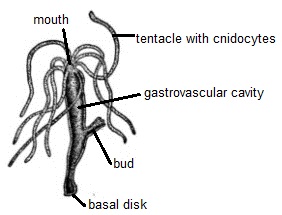Hydra Lab
Prelab Questions:
1. The Hydra belongs to the Kingdom ___Animalia________
and the Phylum _______Cnidaria____________________
2. What are cnidocytes? stinging cells
3. Where do hydra live? fresh water
4. Name two other organisms that are closely related to the hydra.
jellyfish, coral
5. Obtain a slide of a living hydra and observe under scanning and low power. Note that you do not have a cover slip on the slide so you should NOT use the high power objective. The hydra is visible on the slide without the microscope. Make a sketch of your hydra.
6. Because the hydra moves around on the slide, it can be difficult to get a good view of it. Your teacher may provide you with a "Preserved Hydra" slide which contains a hydra that has been fixed to the slide. This hydra is no longer living. Sketch your preserved slide below (or living hydra) and label it.
| Hydra at scanning (40x) | Hydra Tentacle at low power (100x) |
|---|---|
|
Label the: Basal disk | Tentacles | Gastrovascular cavity (area) |
7. Count the number of tentacles on your hydra. How many does it have? ____varies, 7-9 is most common___
Compare this number to other hydras. Are all hydras the same? __no____
8. Hydra Behavior - Use a dissecting pin to gently touch your hydra. Describe its reaction. it will scrunch into a ball, or move
*You may also try adding fish flakes or live Daphnia to your slide to see if you can observe the hydra eating. hydras often don't cooperative with being fed, if you're lucky you can see a daphnia being eaten.
There are several videos on youtube showing hydra eating daphnia or other microorganisms that you could show students if you had a projector - Hydra eating Cyclops

